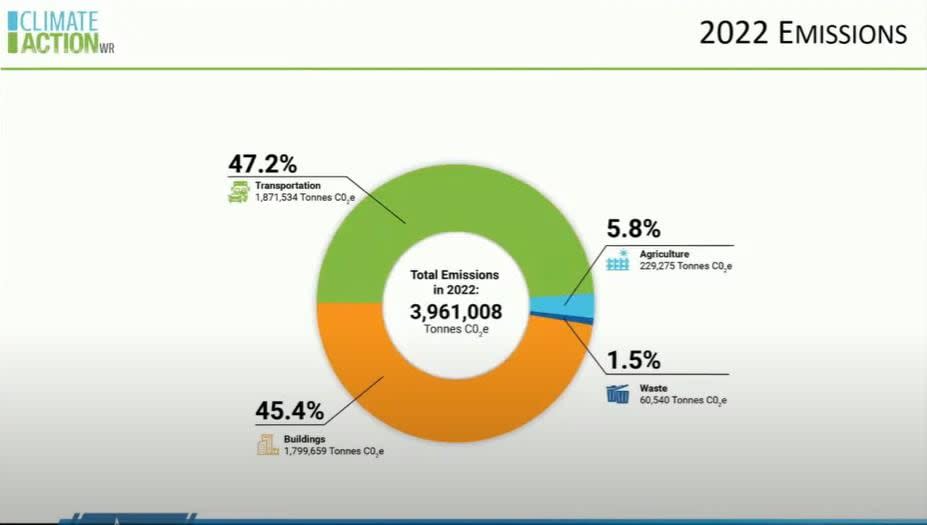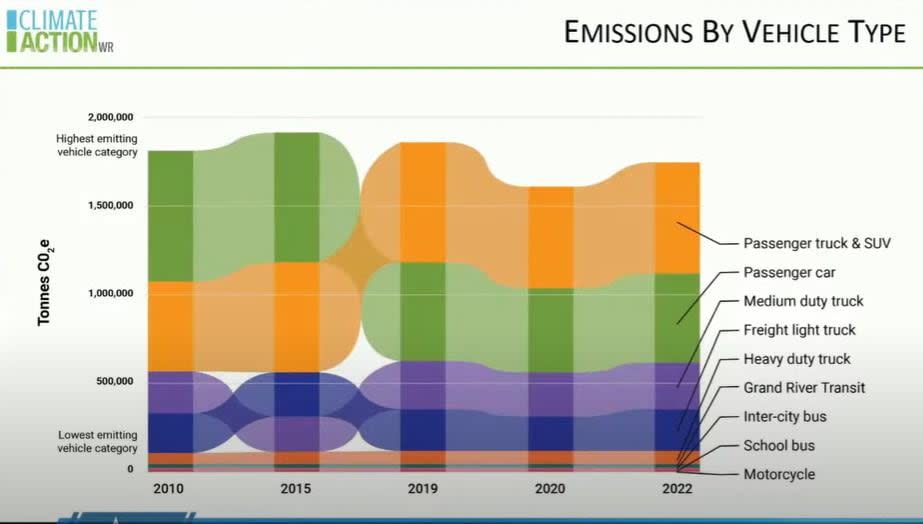Waterloo region falls behind on plan to cut emissions 50% by 2030

Waterloo region needs to scale up its climate actions if it wants to achieve its target of 50 per cent reduction in greenhouse gas (GHG) emissions by 2030, a local community organization says.
The region's planning and works committee got an update Tuesday on progress toward the community GHG target.
In her report, Kyra Chisholm, plan manager at ClimateActionWR, said community GHG emissions in 2022 decreased by 12 per cent below the 2010 baseline. An increase of four per cent over 2020 levels was observed in 2022, primarily driven by the removal of pandemic travel restrictions, she said.
"While 12 per cent shows great progress from our previous six per cent target, I'd like to stress that we are not on track to reaching this 50 by 30 target," Chisholm said.
"Why is this target important? We are in a crucial window to make changes in this decade as part of global efforts to keep warming limited to 1.5 C. It is also a necessary milestone for our long-term target of 80 per cent emissions reduction by 2050."

Transportation emissions account for almost half of Waterloo region’s community wide emissions at 47.2 per cent, followed closely by emissions from buildings at 45.4 per cent, agriculture at 5.8 per cent and waste at 1.5 per cent. (Waterloo Regional Council)
Countries agreed in the 2015 Paris Agreement to try to prevent global warming surpassing 1.5 C, to avoid it unleashing more severe and irreversible consequences.
Chisholm said the transportation emissions account for almost half of Waterloo region's community wide emissions at 47.2 per cent, followed closely by emissions from buildings at 45.4 per cent, agriculture at 5.8 per cent, and waste at 1.5 per cent.
According to Chisholm, passenger vehicles, including cars, light duty trucks and SUVs account for 65 per cent of transportation emissions.
"This is an important indicator of the need to support residents in transitioning to zero emissions vehicles and an increased use of public and active transportation," she said.
For building emissions — industrial, commercial and institutional buildings account for 60 per cent of total building emissions, while residential buildings account for the remaining 40 per cent.
Getting back on track
In order to get back on track for its target of 50 per cent reduction in GHG emissions by 2030, ClimateActionWR recommends the following for the transportation sector:
Invest in robust public transit options and safe active transportation networks.
Accelerate decarbonization of passenger vehicles and equipment both at home and at work.
Support programs that shift community culture toward sustainable transportation modes.

This chart shows changes in emissions from vehicles in Waterloo region. (Waterloo Regional Council)
To support accelerated emissions in buildings, ClimateActionWR recommends the following:
Accelerate adoption of low carbon, fuel switching technologies such as heat pumps for water and space heating (and cooling) both in homes and organizations.
Invest in energy decarbonization.
Adopt policy that prioritizes decarbonization in development.
Climate action must continue to be a collaborative effort
During the same meeting, regional staff presented an update on progress on the Corporate Climate Action Plan, Corporate Energy Plan, Long-Term Waste Management Strategic Plan, and Advancing a Thermal Strategy in Waterloo Region.
Coun. Colleen James, chair of the planning and works committee, said to meet its 2030 targets, "climate action must continue to be a collaborative effort in Waterloo region."
"Today's updates demonstrate how teams across the Region of Waterloo and the community are focused on mitigating and adapting to climate change, supporting a better future for all of us and our future generations," James said.
Waterloo region has implemented 210 of 350 energy projects within the first five years of the Corporate Energy Plan (2019-2028).
The region says highlights of the impacts to community and the corporation include:
Saving $2.2 million in utility costs.
Conserving 11,500 MWh of electricity (equivalent to 1,280 homes).
Conserving 1,340,000 m3 of natural gas (equivalent to 550 homes).
Reducing 3,700 tonnes of GHG emissions (equivalent to 800 vehicles).
Securing almost $5.5 million in funding to advance Regional and community projects.


